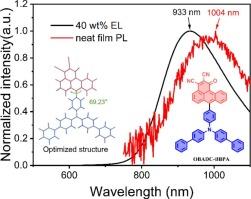分子工程使超过1000 nm的高效热激活延迟荧光发射器成为可能
IF 13.2
1区 工程技术
Q1 ENGINEERING, CHEMICAL
引用次数: 0
摘要
受能隙定律的限制,开发工作在1000 nm以上的高性能近红外(NIR)热激活延迟荧光(TADF)发射器仍然是一个重大挑战。在此,我们开发了一种新型的近红外TADF发射器OBADC-BBPA,它通过将强大的多亚受体1-氧- 1h -苯并[de]蒽-2,3-二碳腈(OBADC)与经典的电子给体联苯苯胺(BBPA)整合,具有很强的分子内电荷转移(CT)效应。在强烈的分子内电荷转移(CT)效应的驱动下,增强π电子离域,降低LUMO能级,OBADC-BBPA整齐薄膜在NIR-II区表现出明显的红移,达到1004 nm。量子计算和光物理实验证实了OBADC-BBPA的TADF性质。基于OBADC-BBPA的溶液可加工NIR oled表现出“真实”的近红外发射(λ起始点为700 nm),其峰值为933 nm,外量子效率(EQE)为0.073 %,代表了迄今为止在类似光谱区域使用TADF发射器的溶液可加工NIR oled的最先进性能。本工作为研制真正的近红外TADF发射器提供了一种可行的分子设计策略。本文章由计算机程序翻译,如有差异,请以英文原文为准。

Molecular engineering enables efficient thermally activated delayed fluorescence emitter exceeding 1000 nm
Restricted by the energy gap law, the development of high-performance near-infrared (NIR) thermally activated delayed fluorescence (TADF) emitters operating beyond 1000 nm remains a significant challenge. Herein, we developed a novel NIR TADF emitter, OBADC-BBPA, which features a strong intramolecular charge transfer (CT) effect through the integration of a powerful multi-sub-acceptor, 1-oxo-1H-benzo[de]anthracene-2,3-dicarbonitrile (OBADC), with the classic electron-donor biphenylphenylamine (BBPA). Driven by the strong intramolecular charge transfer (CT) effect, which enhances π-electron delocalization and lowers the LUMO energy level, the OBADC-BBPA neat film exhibits a distinctly red-shifted emission reaching 1004 nm in the NIR-II region. Quantum calculations and photophysical experiments confirmed the TADF property of OBADC-BBPA. The solution-processable NIR OLEDs based on OBADC-BBPA demonstrates “real” NIR emission (λonset ˃ 700 nm), featuring a peak at 933 nm and an external quantum efficiency (EQE) of 0.073 %, representing the state-of-the-art performance for solution-processable NIR-OLED using TADF emitters in similar spectral region so far. This work provides a feasible strategy of molecular design for developing real NIR TADF emitters.
求助全文
通过发布文献求助,成功后即可免费获取论文全文。
去求助
来源期刊

Chemical Engineering Journal
工程技术-工程:化工
CiteScore
21.70
自引率
9.30%
发文量
6781
审稿时长
2.4 months
期刊介绍:
The Chemical Engineering Journal is an international research journal that invites contributions of original and novel fundamental research. It aims to provide an international platform for presenting original fundamental research, interpretative reviews, and discussions on new developments in chemical engineering. The journal welcomes papers that describe novel theory and its practical application, as well as those that demonstrate the transfer of techniques from other disciplines. It also welcomes reports on carefully conducted experimental work that is soundly interpreted. The main focus of the journal is on original and rigorous research results that have broad significance. The Catalysis section within the Chemical Engineering Journal focuses specifically on Experimental and Theoretical studies in the fields of heterogeneous catalysis, molecular catalysis, and biocatalysis. These studies have industrial impact on various sectors such as chemicals, energy, materials, foods, healthcare, and environmental protection.
 求助内容:
求助内容: 应助结果提醒方式:
应助结果提醒方式:


